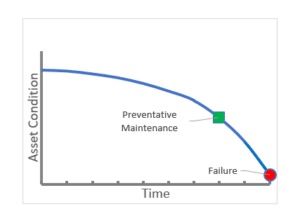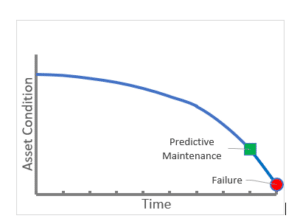Industry 4.0, or the Fourth Industrial Revolution, is characterized by massive improvements in artificial intelligence and machine learning. All around us, our devices are becoming more and more equipped with the ability to understand themselves and their surrounding environment. Cell phones, computers, vehicles, and even retail stores are taking advantage of these improvements to cut down on waste and improve efficiency and convenience in our lives. In today’s day and age, there’s no reason that we can’t employ the same technologies to maintain our assets and improve the efficiency of our daily operations.
In this article:
1. What is Industry 4.0 Predictive Maintenance?
2. Examples of Predictive Maintenance
3. Why Use Predictive Maintenance Over Preventative Maintenance?
4. Advantages of Predictive Maintenance
5. Disadvantages of Predictive Maintenance
6. The Future of Industry 4.0 Predictive Maintenance
What is Industry 4.0 Predictive Maintenance?
Predictive maintenance, or PdM for short, leverages condition monitoring and AI with data analysis to cut down on wasted time and money spent on maintenance that didn’t need to happen in the first place. This is a method used by companies to maintain their assets as an alternative to performing traditional preventative maintenance. Some shocking facts were discovered in an analysis from Oniqua Enterprise Analytics regarding preventative maintenance, including:
· As much as 40% of costs associated with preventative maintenance are spent on assets with negligible failure impact.
· Up to 25% of labor performed in maintenance operations is wasted.
· Up to 30% of every dollar spent on preventative maintenance is wasted.
To make matters worse, the fact these resources are wasted can frequently be hidden, since it may not be obvious that unnecessary maintenance is being performed. It only follows that we should look to predictive maintenance, when possible, to reduce the frequency of wasteful maintenance.
Examples of Predictive Maintenance
Most readers will already have some experience with predictive maintenance, as one basic example is a tire pressure sensor that modern vehicles are equipped with. Let’s assume a car tire should have an air pressure of 32 to 35 psi. If said tire were to spring a small leak and slowly lose pressure over the course of a month, it would eventually reach a point where the tire fails and can no longer support the car. But if a pressure sensor within the tire alerts us that it’s psi has dropped to 30, we can act before any major damage is done. This is an example of a rule-based predictive maintenance measure, wherein the rule is that psi should be within the range of 32 to 35. Other examples of rule-based measures might use an infrared sensor to check if a machine is overheating or a vibration sensor to detect when an engine is behaving abnormally. These rule-based measures are relatively simple but still require knowledge of which conditions should be checked for. Realistically, an asset may have several different sensors acting on it at one time that will feed data to an algorithm.
There exist more complicated forms of predictive maintenance, which take advantage of modern machine learning. Using historical data, algorithms can be developed to understand how an asset should perform over time. Then, using feedback from sensors, an algorithm can identify anomalies in performance as they happen and suggest maintenance measures. These can be supremely effective, but not all companies may have the necessary data or have the data in a clean status where it can be integrated with other tools. Specialists will need to work with the data to then develop a model to predict the remaining useful lifetime, or RUL, of an asset. Finally, with the RUL in hand, maintenance events can be scheduled at a time when the asset is more likely to need maintenance performed. Through this process, maintenance costs can be slashed, and less waste is produced.
Why Use Predictive Maintenance Over Preventative Maintenance?
Preventative maintenance consists of regularly scheduled maintenance events, wherein parts or assets are replaced or maintained in advance of when they are expected to fail, with the goal of preventing a failure from occurring at all. While preventative maintenance is still plenty useful, it is also wasteful by its very design.
Prevention of a failure means performing maintenance well ahead of the time that an asset is expected to fail, meaning any time between the time of maintenance and the time of failure is wasted, as demonstrated by RealPars and recreated in Figure 1: Asset Condition vs. Time (Preventative) and Figure 2: Asset Condition vs Time (Predictive). The graph in Figure 1 shows a hypothetical asset approaching failure and the time wasted is represented by the difference in time between preventative maintenance and failure.
Similarly, Figure 2 shows the same asset, while the only difference is that a predictive maintenance measure has been implemented. Notice that the difference in time between the predictive maintenance and failure is smaller than the difference in Figure 1, meaning less time was wasted and more use was extracted from the asset when adhering to predictive maintenance methodologies.

Figure 1: Asset Condition vs. Time (Preventative)
Source: https://realpars.com/predictive-maintenance/

Figure 2: Asset Condition vs Time (Predictive)
Source: https://realpars.com/predictive-maintenance/
In an ideal world, we would be able to perform maintenance on an asset just moments before failure, every time. Of course, this is not possible because we can’t predict exactly when a malfunction will occur, but predictive maintenance will lessen the gap of wasted time. As predictive maintenance technology and algorithms improve, this gap of wasted time will only get smaller.
In other words, predictive maintenance helps to strike a balance between maintaining too much and too little. That said, preventative maintenance still has its place and will frequently be used in conjunction with predictive maintenance. Choosing to enlist predictive maintenance measures versus preventative ones will vary from asset to asset and from facility to facility. It should also be noted that predictive maintenance often comes with a high implementation cost as well as a high skill floor for using the measures effectively.
Advantages of Predictive Maintenance
It has been shown that the implementation of predictive maintenance measures is cost-effective in terms of minimizing downtime, and lost production hours, as well as the need for spare parts and reactionary maintenance. In some cases, it can even lead to a tenfold return on investment by means of reducing maintenance costs, breakdowns, and downtime. Predictive maintenance allows companies to extract more of their asset’s remaining useful lifetime by cutting down on premature maintenance that is largely wasteful. It focuses on parts and assets that actively show their condition worsening, whereas other kinds of maintenance focus resources on parts and assets that are still in good condition.
Disadvantages of Predictive Maintenance
While the benefits of predictive maintenance are clear, it may not be obvious what the downsides are or what hurdles will need to be overcome to implement an effective predictive maintenance program. As mentioned earlier, the initial investment to create such a strategy is high. Some of the things that a company will need include:
· Additional equipment will be needed to take readings and gather data.
· It will require a sufficient historical data set which takes time and/or money to gather.
· Software support will be needed.
· A team of specialists is required to interpret the data and develop models that will predict when maintenance should be performed.
· Predictive maintenance may not be appropriate for every asset.
These are only some of the obstacles in the way of implementing a predictive maintenance strategy; there are always surprises and other unexpected costs. It may seem like starting from scratch when a company already has a thorough preventative maintenance plan in place.
The Future of Industry 4.0 Predictive Maintenance
Industry 4.0 has shown time and time again its ability to take abstract and complicated problems and create a conveniently boxed-up solution to them. For that reason, it shouldn’t surprise anyone when Industry 4.0 delivers a more convenient way to incorporate predictive maintenance strategies. An analysis from Research and Markets estimates that the predictive maintenance market will grow from $4.2 billion in 2021 to $15.9 billion by 2026, with an annual growth rate of 30.6%. Companies are moving from on-prem to cloud-based asset management and they are looking to have predictive maintenance solutions integrated with their asset management. As the technology becomes more accessible, more companies will be able to get their foot in the PdM door and make their investment pay off.
Technology and AI surrounding predictive maintenance will only continue to improve, meaning the gap of lost time between maintenance and failure seen earlier will become smaller, so the return on investment will grow larger yet. Predictive maintenance will be integrated with a company’s asset management software and become part of their best practices, resulting in hugely cut costs, downtime to a minimum, and a much deeper understanding of what makes their assets tick.
Sources:
https://www.researchandmarkets.com/reports/5134994/global-predictive-maintenance-market-with-covid
https://www.fiixsoftware.com/maintenance-strategies/predictive-maintenance/
https://towardsdatascience.com/how-to-implement-machine-learning-for-predictive-maintenance-4633cdbe4860
https://www.iotforall.com/a-guide-to-industry-4-0-predictive-maintenance

